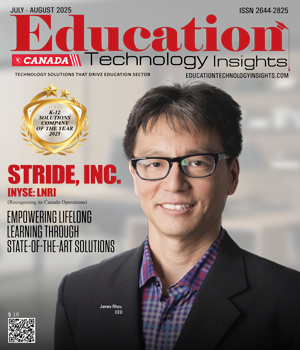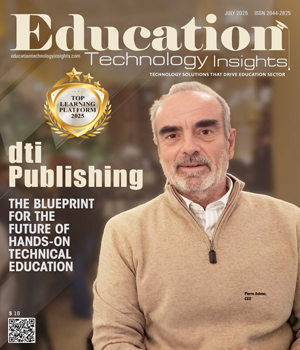THANK YOU FOR SUBSCRIBING
Be first to read the latest tech news, Industry Leader's Insights, and CIO interviews of medium and large enterprises exclusively from Education Technology Insights
Modern Educational Paradigms are Shifting How We Educate
June Evans-Caulfield, Head of Teaching and Learning - Middle Years, Workshop Leader at Caulfield Grammar School
 June Evans-Caulfield, Head of Teaching and Learning - Middle Years, Workshop Leader at Caulfield Grammar School
June Evans-Caulfield, Head of Teaching and Learning - Middle Years, Workshop Leader at Caulfield Grammar SchoolJune Evans-Caulfield is an experienced Educator and IB Workshop Leader with a proven track record in International and National Educational Programs. She is skilled in Workshop Leadership, Curriculum Development, Secondary Education and Educational Technology. June is passionate about running effective educational programs and fostering professional growth.
Through this article, June Evans-Caulfield shares her insights on the evolution from traditional to modern educational frameworks. Modern approaches go beyond content and skills, integrating concepts and inquiry-based learning to develop higher-order thinking, creativity and metacognitive skills. This student-centered approach aims to prepare learners for adaptability and innovation in a dynamic world, emphasizing active learning, reflection and autonomy.
Our world is continually evolving and how we educate is shifting to align with our changing needs. Modern educational frameworks embrace a broader scope of what, why and how we learn which may better prepare our young people for their lives and how they live them. Modern educational paradigms are designed to suit a wide range of learners and include broader approaches to learning. As a result, this should better prepare young people to make the right choices for future workplace employment. It also should equip them with the flexibility to switch and change.
Traditional educational frameworks are content and skills-based, unlike modern educational models which are three-dimensional to include concepts, content and skills. Modern frameworks recognize the value of concepts driving content and skills that are related to themes, big ideas and inquiry. The learner is exposed to deeper thinking through higher-order thinking skills that transfer. Three-dimensional frameworks embrace concepts as a key component in learning.
“Modern educational models emphasize higher-order thinking skills and creativity as key elements to embed in the learning process, coupled with metacognitive skills filtered throughout the learning experience.”
This is not to say that content knowledge is still not very valued, but the focus is not solely on it alone. Modern approaches add to this knowledge by delving deeper through conceptual approaches and using such theories as constructivism to create meaning and build knowledge through experiences of active and authentic learning. This adds meaning, humanizes situations, seeks answers to problems and allows for questioning and inquiring in ways that tap into creativity and critical thinking skills. It is this that gives our young people the best chance to be successful, innovative, adaptable and productive in our continually evolving world.
There are many different ways of utilizing and creating environments that align with modern educational models that benefit learners. Concept-based approaches and inquiry-driven environments lend themselves to learning space design that encourages questioning, probing, research, finding and seeking, open discussions, teamwork, collaboration, active learning, active listening and reflection on what, why and how of learning. This type of learning allows the learner to draw on higher-order cognitive processing skills. They can build their understandings and create new conceptual understandings through their actions and products. This may be much more powerful when lower-order thinking skills are blended effectively into the matrix.
Modern educational models by their very nature also are more student-centered and student-focused. Student engagement should increase when the learner is a featured part of the process and if they feel they have an element of control over their learning. By creating autonomy, we are automatically giving credit and value to a person and personalizing their learning. We can also take this opportunity to create safe spaces to nurture and develop trust, respect and human connections. It is this that most likely will have a positive flow-on effect on the outcomes. Throughout the whole process, the learner is guided to continually think about how they best learn metacognitively. As such, they will gain more of an awareness of how this experience helps them interact with the learning.
For educators and those we educate, good educational programs are catalysts for positive change and we need dynamic transformative educational programs that change with time. This is even more and more apparent in the light of advancements in AI. Modern educational models do not shy away from change. They are designed to embrace concepts, content and transferable skills through disciplinary, interdisciplinary and transdisciplinary approaches. They emphasize higher-order thinking skills and creativity as key elements to embed in the learning process. This is coupled with metacognitive skills filtered throughout the learning experience. Young people are encouraged to continually reflect and think about what they are learning, how they best learn and how they approach this learning.
Ultimately, it is essential to have an interplay between levels of thinking that start at the lower end of knowledge skills that need to be connected to higher levels of thinking. It is important and necessary to have a knowledge base. The ability to remember information can be gained via memorization and rote learning. This is both useful and needed, but to be more highly effective, we need connections that are made to it through ideas, concepts and skills that transfer. It is this that allows for more complex thinking.
Read Also
Step into The Future: How Inspired's Metaverse is Transforming Learning
Nurturing our Future Learners - The Spark that ignites Creativity
Balancing Human Connection and Technology for Impact
Applied Microcredentials for Opportune Upskilling in Aquaculture
Empowering Teachers to Use AI with Discernment
Preparing Students for an AI Future

I agree We use cookies on this website to enhance your user experience. By clicking any link on this page you are giving your consent for us to set cookies. More info














